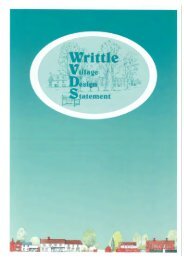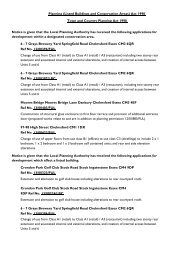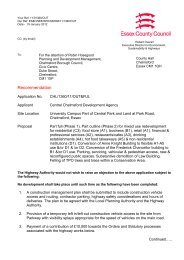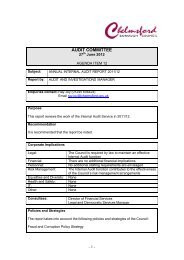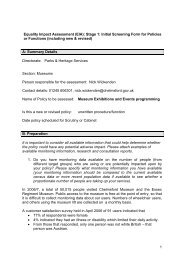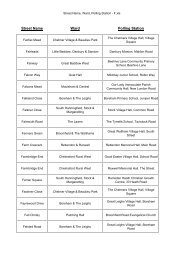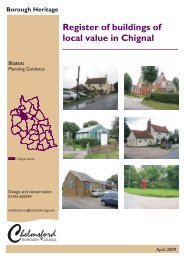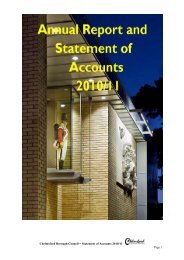Landscape Character Assessment - Chelmsford Borough Council
Landscape Character Assessment - Chelmsford Borough Council
Landscape Character Assessment - Chelmsford Borough Council
Create successful ePaper yourself
Turn your PDF publications into a flip-book with our unique Google optimized e-Paper software.
26alternative sources from outside the area are used. Once the sand and gravel pits are closed,restoration of the landscape occurs in places such as surrounding Hatfield Peverel Gravel pitswhere they have been filled with water and the surroundings planted with trees andlandscaped. With regard to waste, despite moves away from landfill as the primary means ofwaste disposal, this is likely to continue for some time, such as at Rivenhall disused airfield,and other methods of waste management may create new pressures on the landscape.2.4.27 The key issues affecting landscape character include: The effects of minerals/landfill operations including changes to field pattern, loss oflandscape features, introduction of alien landforms, land raising, haulage routes andlighting. The effects of restoration schemes depending on restoration to agriculture, woodland orother uses, and whether these are sympathetic to landscape character. Extensive quarrying and inappropriate restoration causing loss of hedgerow pattern anduncharacteristic landform.Climate Change2.4.28 It is widely acknowledged that global climate change is inevitable, and that it is likely to havesignificant physical impacts on the landscape. The South East region including Essex isparticularly sensitive to the effects of climate change. Changes in the form of increasedtemperatures, wetter winters, and more extreme weather events have been identified in thelast 10 years. The scenarios produced by the UK Climate Impacts Programme (UKCIP02)suggests by 2080 the UK is likely to experience: Annual temperature rises by between 2 and 3.5 o C. More frequent high summer temperatures and very cold winters becoming increasinglyrare. Winters becoming wetter and summers becoming drier. More frequent summer droughts, winter flooding and storms. Sea-levels rising between 26 and 86 cm above the current level in South East England.2.4.29 Whilst there are still uncertainties regarding exact changes at regional and local levels, it isclear there could be both direct and indirect impacts on landscape character. The coastal areais a critical and irreplaceable natural asset supporting diverse internationally importanthabitats. The potential implications for landscape character includes changes in habitats, andspecies composition, habitat fragmentation, water resources, soils, agricultural land use,recreation and tourism and cultural heritage.2.4.30 There is future pressure for further intensification of the coastal grazing marsh habitat,however, there is also possible future potential for saltmarsh habitat creation and restorationthrough managed realignment along certain stretches of the coastline (with regard toinformation set out within the Essex Estuarine Strategy). This strategy (commissioned by theEnvironment Agency) states that, whilst there will ‘always be locations that must beprotected by traditional hard defences, Managed Realignment can also be seen as importantin terms of creating new habitats, providing new recreational areas, and producing localeconomic gain.’2.4.31 The key issues affecting landscape character include: Increases in sea levels, especially if coupled with increases in storm activity, may causegreater erosion of habitats such as intertidal mudflats and salt marsh.Section 2.0 – Overview of the Study Area11100101R Final LCAs_09-06



